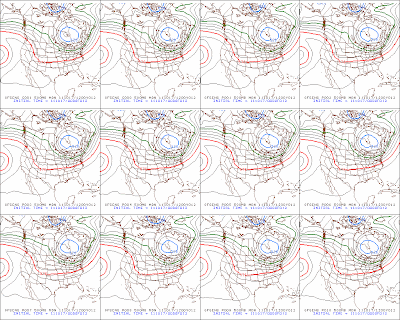What Jefferson was saying was, Hey! You know, we left this England place 'cause it was bogus; so if we don't get some cool rules ourselves - pronto - we'll just be bogus too!
- Jeff Spicoli, Fast Times at Ridgemont High
- Jeff Spicoli, Fast Times at Ridgemont High
Much can be learned about meteorology from Jeff Spicoli. If I can paraphrase, "What Steenburgh was saying was, Hey! Ten-day icon-based weather forecasts are bogus, and if we don't get some better forecasts - pronto - we'll just be bogus too!"
Ten-day icon-based weather forecasts have spread through web- and television forecasts like a pandemic. Here's an example from weather.com.
Meteorologists have known for decades that the atmosphere is a chaotic system and have even developed modeling systems known as ensembles to try and get a better handle on the full range of possibilities and forecast confidence. Sometimes the weather in a particular region is fairly predictable on long lead times, but other times it isn't. Yet, these icons provide no information on forecast confidence, with the exception of the chance of rain at the bottom.
Numerical weather forecasts are sensitive to their initial conditions, and this places a limit on weather prediction and forecast skill. Let's take, for example, the forecasts produced by the 0000 UTC Global Ensemble Forecast System (GEFS). These forecasts start with very similar, but slightly different, initial conditions that are consistent with the available data. If we look at the 12-h 500-mb height forecasts valid this morning, they are virtually indistinguishable.
 |
| Source: PSU E-wall. |
But, there is more variability in the ensemble members when we get out 10 days, which corresponds to the weather.com forecast of AM clouds/PM sun for Oct 26.
 |
| Source: PSU E-wall. |
Most of the ensemble members put a long-wave ridge over the western US and a trough over the east, but not all. For example, member P006 (center right) puts the trough over the west-central US and Utah is in a much colder northerly large-scale flow. Member P010 (lower right) puts a trough over the Pacific Northwest.
Because there is some agreement amongst the ensemble members, a best-guess forecast might be for dry conditions to prevail on Oct 26th, but that's not guaranteed and we simply can't justify a single forecast of AM clouds/PM sun, high 59, low 43. This example is relatively benign, but sometimes the ensemble is very mixed or hints at the potential of high-impact weather event. In both cases, the lack of predictability or the possibility of a major storm are entirely glossed over in an icon-based forecast. The bottom line is that icon-based 10-day forecasts are bogus and, if you use them, then you'll be bogus too.



Apparently you can use a super secret proprietary system to forecast up to a year in advance.
ReplyDeleteI love how they call it "science"! How about some verification? Oh wait, it's proprietary so they can't release the results...
https://apps.planalytics.com/weatherplanner/faces/about/how/
ReplyDeleteSorry, the link didn't make it in there the furst time.
It would be so easy for them to introduce a forecast confidence scale (perhaps low, medium, high or a 1-5 scale). This might give a 10-day outlook attempt at least some credibility.
ReplyDeleteVery interested in this topic... coming from a broadcast perspective. This is an issue that warrants some kind of round table discussion with media/nws/and other meteorologists. There does need to be a change in the way we present long range forecasts- but it's not going to be easy. Think of it terms of fast food. It's easy for someone to say 'kids need to make healthy choices'... but then you drive by 20 KFC's and McDonald's on the way to school. Like fast food, 'fast forecasts' (icon based) are a part of our high tech world. Even if one media source changed the way forecasts were presented, you'd still have scores of other 10-day forecasts from other sources. The public would be confused. (In fact, sad to say the public might even think a media source is 'weak' if it admits uncertainty.) The only way to fix the problem is for some 'universal' agreement from all sources of weather media. Could this happen? -Grant Weyman
ReplyDeleteGrant -
ReplyDeleteIf I am interpreting your comments correctly, it is that icon forecasts, like fast food, are here to stay. I think you are correct about this. I suspect that an agreement will never work, but hopefully savvy weather users will recognize that icon-based long-range forecast are of limited value and seek other options, much as savvy diners recognize that a Big Mac with fries has limited nutritional value.
Maybe someone will come up with a better way to do the icons and, if that proves popular, then you can bet everyone will start doing it. If only Steve Jobs were still alive...
Jim
However the measurements and forecasts observed in every county give an important contribution to the worldwide network and allow more data to be fed into the computer models.
ReplyDelete